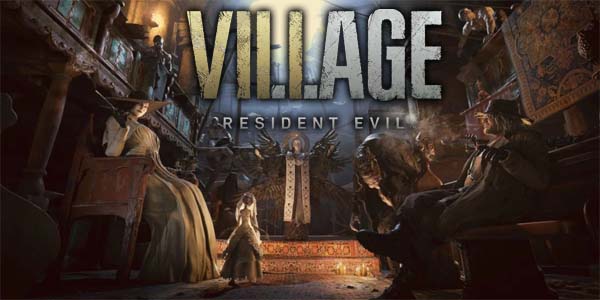
Village seems to be positioning itself as a sort of "greatest hits" of earlier Resident Evil games. I'm not sure it all comes together as well as Capcom must have hoped it would. Resident Evil VII Biohazard did an excellent job of modernizing the design philosophies of the original Resident Evil game. Map design, inventory and resource constraints, and the "fight or flight" nature of enemy encounters all perfectly re-captured the feel of the original PS1 classics, without all of the clunkiness.
Village maintains the exploratory map design of the original Resident Evil and of Resident Evil VII, but it also tries to port concepts and aesthetics from the Resident Evil 2 remake and from Resident Evil 4. The RE2 stuff fits well enough, but the RE4 influences just don't feel compatible with classic design philosophy.
The setting instantly reminded me of Resident Evil 4.
Clash of philosophies
Right off the bat, the general aesthetic screams "Resident Evil 4". The game begins in a small, rustic, eastern European village at the foot of a gothic castle. Just like in RE4, you're quickly ambushed by the monstrous villagers and have to desperately fight your way out. Resident Evil 4 replaced the traditional zombies of the series with semi-aware "ganados"; Village similarly breaks away from the traditional zombies, but this time, the monsters are werewolves.
Not long into the game, you'll start smashing crates to reveal hidden loot, and pixel-hunting along the walls and ceilings for obnoxious sparkling gems to shoot down and collect. Also just like in Resident Evil 4, you'll routinely get rewards of items and money from defeated enemies. That money and loot is used to buy items or upgrade your equipment at a shop, just like in Resident Evil 4. This is where the game started to break down for me.
Loot, ammo, and cash can be recovered from smashed crates or defeated enemies.
Giving the player rewards of in-game cash for defeating foes (and for wasting bullets to shoot glowing gems off of walls) completely changes the motivations of the player in how we deal with enemies. I'm no longer carefully considering whether to try to sneak past an enemy or run away, nor am I ever firing off a single round at an enemy's knee to stun or cripple it so I can get away without consuming more resources, the way I might in REmake2. Since every defeated foe returns some of the resources that I invest into killing it, there is no "fight or flight"; only "fight". The enemies stop being threatening or frightening, especially on the standard difficulty setting, in which ammunition is readily available and the monsters patiently await their turns to charge and attack.
Even inventory management is mostly thoughtless. The more linear, more action-oriented, and less puzzle-oriented design of the game means that key items and treasures are not put in your limited inventory, and there isn't even a storage box to keep excess weapons or supplies. Only weapons, ammo, and healing items go into your briefcase. Everything else has unlimited storage. Even crafting components have separate, unlimited storage (the only exception being the animals meats needed for the Duke to cook meals -- more on this later). [More]
b05b0e00-39c0-4ac3-9d47-9089537c0f54|1|5.0
Tags:Resident Evil, Resident Evil VIII Village, Capcom, horror, survival horror, action, shooter, Resident Evil 4, gothic horror, vampire, werewolf, Ethan Winters, Lady Dimitrescu, castle
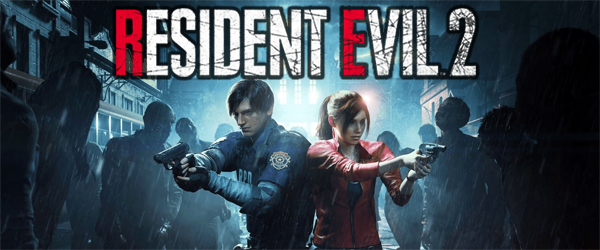
Getting started with this game was rough. First of all, streaming the game initially seemed to be blocked by Capcom, which sent me down an internet rabbit hole of trying to find a work-around. If I couldn't stream or capture gameplay, then it would be awfully hard for me to get decent screenshots -- let alone any video for possible YouTube content. I even Tweeted @AskPlaystation whether I could get a refund, so that I could instead purchase the game on Steam (where I knew I'd be able to record footage). @AskPlaystation never responded.
It was moot anyway, since the next day, I found that the problem was only associated with having High Dynamic Range (HDR) enabled in the PS4's settings. After disabling HDR, I was able to stream the game and capture video footage as normal. Of course, the game's colors didn't look so good -- but whatever, I could live with it. I guess this is a glitch. Maybe Capcom will fix the HDR streaming issue at some point in the future? I can't imagine that they deliberately disabled streaming with HDR, but left it enabled when HDR isn't being used.
You'll need to disable High Dynamic Range (HDR) on the PS4 if you want to stream REmake 2.
But even when I got the streaming and capture functionality working, I lost another night having to troubleshoot my PS4's network connectivity. I kept getting a DNS error. My PS4 has had internet connectivity issues off and on for years, so it might just have a bad network card. Or maybe my ISP is throttling it? It's hard to tell. The console regularly connects to the router and obtains an IP, but then fails to connect to the internet. Or it can connect to the internet, but fails to connect to PSN.
After several hours of troubleshooting, I had to manually enter the DNS addresses of my router's second and third DNS as the PS4's primary and secondary DNS, then sign out of the PSN, then boot up the PS4 in safe mode, then run a database rebuild (which took a few minutes), then reconnect to the PSN. That seems to have worked ... for now. We'll see how long the fix lasts...
In any case, these streaming and network issues cost me the first full weekend with the game. I'd have to play it on weeknights after work instead. Hopefully the game's quality would make up for these early frustrations...
I have adapted much of this review into a video critique on YouTube, if you'd prefer to watch a video.
The failure of REmake2's "hardcore" save system
Years ago, in the early years of this blog, I wrote an opinion piece called "The Genius of Resident Evil's classic save system". In that blog post, I wrote about how the way in which classic survival horror games (and Resident Evil in particular) limited the player's ability to save actually helped to amplify the horror atmosphere, while simultaneously facilitating open-ended exploration and creating the genre's trademark resource-management gameplay. I love the old Ink Ribbon method of saving, and I was thrilled that the brilliant REmake maintained these old systems to excellent effect. Other games like RE7 and Alien: Isolation also brought back more traditional survival horror save systems, but without the added complexity tying it to a consumable item (at least not by default).
Unfortunately, REmake 2's save system doesn't fare so well. By default, the game apparently uses autosaves and checkpoints, and you can manually save at typewriters without an Ink Ribbon. It all works similar to RE7. However, you can play on "hardcore" mode (which is available by default) to get an experience more similar to the original save system. Except, it doesn't work as well. In fact, it seems to be fundamentally broken.
It would be nice if the game would use Ink Ribbons from the item box,
rather than having to put it in your inventory, then put it back in the item box after you save.
Part of the reason for this is that the "hardcore" mode also doubles as the game's "hard" difficulty. On the "hardcore" mode, there are no autosaves or checkpoints, and you must consume an Ink Ribbon to save at the typewriters (just as in the original release). However, enemies also have more health and deal more damage, and resources are more scarce (Ink Ribbons apparently replace ammo pickups in certain places). This screws with the balance of the game such that the manual save system becomes less viable for a first-time playthrough.
... [More]
b46ccf26-8b91-4d4c-8bea-6508764790d3|9|2.6
Tags:PC, Leon Kennedy, Resident Evil, Resident Evil 2, Claire Redfield, zombie, remake, fallacy of sunk cost, Resident Evil 4, autosave, Capcom, Sony, save system, PlayStation 4, ink ribbon, Steam, typewriter, PC, Mr. X, Leon Kennedy, Tyrant, Claire Redfield, YouTube, zombie, fallacy of sunk cost, autosave, save system, ink ribbon, typewriter, Mr. X, Tyrant, YouTube
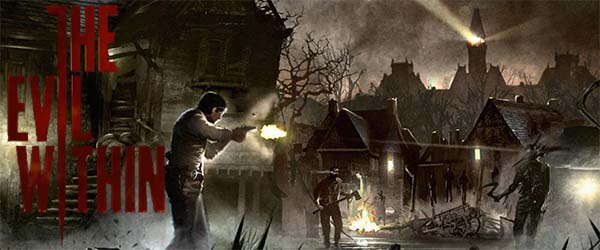
I had some really high hopes for The Evil Within. It looked like Shinji Mikami was trying to bridge a gap between the survival horror trappings of the original Resident Evil and the more action-oriented shooter gameplay style of Resident Evil 4. The former was a slower-paced game that emphasized open-ended exploration, puzzle-solving, and resource management in a horror setting. The latter game dropped most of its horror ambitions in favor of totally campy action shooter schlock. Early trailers for Evil Within looked it would hit a good balance between the two styles.
I didn't jump right on this game at release because I saw some mediocre reviews and heard that it failed to deliver on its promises. After booting up the game, waiting for an hour-and-a-half for the 4.7 GB update file to install (what did this update do? Tack on a whole new game?!), navigating the slick title menu, and then proceeding through the first few chapters, I verified that the game does indeed fail considerably as a horror game.
But it is worth noting that The Evil Within (unlike Resident Evil 4 and Shadows of the Damned) does seem to be making a legitimate attempt at being a horror game, rather than just an action shooter with zombies. It just doesn't really succeed at this goal.
Early levels in particular are full of exceptional lighting and ambient effects that really help to build an ominous atmosphere. The addition of stealth mechanics does put a greater emphasis on avoiding direct conflict and encouraging a more cautious approach (compared to RE4's guns-a-blazing attitude).
I've heard a lot of complaints that this game's story doesn't make sense and is stupid. I think most of these people didn't finish the game (or at least get to the point around chapter 10 where the story is explained). The story makes sense. The problem is that the game is very disjoint and never really builds on these foundations.
The game's narrative causes the character to jump (seemingly at random) from place to place - even within a single chapter. Each new place quickly starts to feel like a narrow-scope set-piece for an action scene rather than any kind of terrifying world. The game and individual chapters lack narrative cohesion and unifying design. There's very little opportunity for the game to allow open exploration or atmosphere-building, since the whole game feels like a collection of randomly-thrown-together set pieces and battle puzzles. So even though the overall story makes sense (in retrospect), the individual scene and level-progression doesn't.
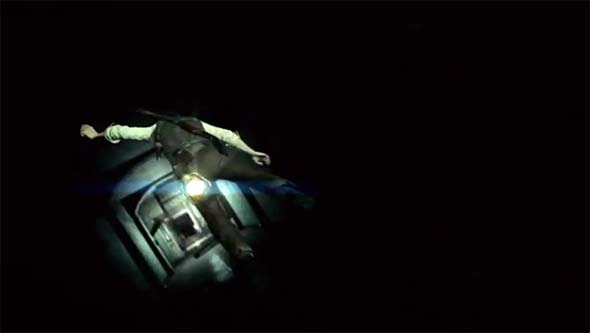
Reality is being warped, resulting in some trippy effects, but a very disjoint sense of progression.
The designers seem to be trying to mimic the Otherworld of Silent Hill, but the transition is so jarring, and the places feel so completely unrelated to one another, that it just doesn't work. You get through a pain in the ass, trap-infested maze while dodging monsters, only to be teleported to another maze area when you reach the exit! "OK, we're done with this area, let's just go to some other random challenge room." There's no sense of ever achieving anything because you're rarely ever allowed to actually go to the places that you are trying so hard to get to. And once that sense of futility sets in, any fear starts to dissipate. You're no longer concerned with getting out or saving yourself or even progressing the story because you realize that you can't achieve anything without the game giving it to you.
It's a real shame too, because some of these reality-warping mind tricks might be very effective if they were organically integrated into the flow of the game. I especially liked one bit in which a character falls down a bottomless pit, only to have the whole world re-orient itself so that the walls become the floor. So instead of falling to his death, he harmlessly rolls to a stop. Unfortunately, these effects lack subtly and feel random... [More]
ce16d91f-e2af-4e72-9f81-822136d27e6a|2|3.5
Tags:The Evil Within, Bethesda, Tango Gameworks, survival horror, action, shooter, stealth, Sebastian Castellanos, zombies, mental institution, Shinji Mikami, Resident Evil 4

Are you as sick of zombies as I am? They're everywhere. Perhaps the real zombie apocalypse won't be caused by radiation or a genetically-engineered plague; it will be caused by media corporations drowning our brains in zombie entertainment until we all go crazy and start eating each other.
Table of Contents
Fungus zombies
OK, sure, the creatures in Naughty Dog's latest adventure game, The Last of Us, aren't actually "zombies", they are humans infected with a fictionalized variation of Ophiocordyceps Unilateralis. But they're functionally the same thing. The "infected", as they are known as in the game, are mindless, mutated monsters that shamble around and eat any human they become aware of. And if they bite you, you become infected and the fungus takes over your brain, turns your flesh into spore-producing tendrils, and makes you a cannibal.
[LEFT] An ant infected with cordyceps.
[CENTER] A moth infected with cordyceps.
[RIGHT] A human infected with cordyceps, as depicted in The Last of Us.
The game takes place 20 years after the sudden outbreak of the human cordyceps infection that leads to the death of the protagonist's daughter. Society has collapsed into ruin, with the surviving 40% of people (including the protagonist, Joel) concentrated in quarantined ghettos in the remains of major cities. Joel is working as a smuggler, bringing food, weapons, and supplies into the Boston quarantine zone to be sold on the black market, and he is tasked with escorting a young girl, named Ellie, to a research lab out west. Ellie is unique in that she seems to be immune to the cordyceps infection. She was bitten weeks ago, and has suffered nothing more than some ugly skin lesions near the bite; whereas, everyone else begins to turn into a zombie within hours of being infected. This, of course, makes her survival paramount, and Joel must do whatever it takes to ensure her safe arrival at the lab so that the researchers can hopefully study her to find a cure or vaccine. [More]
b37fff55-ed98-484c-be2f-cd521976fb05|5|5.0
Tags:The Last of Us, Naughty Dog, Sony, PlayStation 3, PS3, review, action, adventure, platformer, survival, horror, survival horror, Joel, Ellie, cordyceps, fungus, cordie, zombie, ethics, morality, Hippocratic Oath, ludonarrative, Uncharted, Silent Hill 2, Resident Evil 4
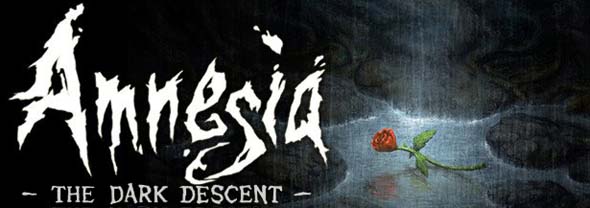
Since Silent Hill Downpour failed miserably to scratch my survival horror itch, I’ve been looking for something else to fill that niche. I picked up Amnesia: the Dark Descent on a Steam sale for pocket change, and am very glad that I did.
Mainstream game companies don’t seem particularly interested in releasing good survival horror games. It’s a very niche market and difficult to find mass-market appeal. Modern horror games mostly ape off of Resident Evil 4 by being designed as an action shooter first, and survival horror game second (if at all). The genre is dominated by fast-paced "boo"-scare games like Dead Space and F.E.A.R., and gone are the days of the deliberately-slow-paced psychological games like Silent Hill 2 and Fatal Frame. The "survival" element has mostly fallen away since resource management is widely regarded as too tedious, and the "horror" is usually just represented with difficult combat.
But where mega-publishers and AAA developers have dropped the ball, the Indie market filled in the gap 3 years ago (Sept 2010) with Amnesia: the Dark Descent.
Amnesia goes to the opposite extreme as Resident Evil 4 and Dead Space. This game is not an action game. [More]
dcd7f8cf-6f87-43f5-bf47-23ebe40b5ba4|3|4.7
Tags:Amnesia: the Dark Descent, Frictional Games, Steam, PC, H.P. Lovecraft, review, steampunk, survival, horror, survival horror, macabre, amnesia, sanity, Silent Hill Downpour, Silent Hill Shattered Memories, Dead Space, Resident Evil 4, Eternal Darkness, checkpoint, indie gaming
|

| 12 | | | | | | | 60 | | 11 | | | | | | | 55 | | 10 | | | | | | | 50 | | 09 | | | | | | | 45 | | 08 | | | | | | | 40 | | 07 | | | | | | | 35 | | 06 | | | | | | | 30 | | 05 | | | | | | | 25 | | 04 | | | | | | | 20 | | 03 | | | | | | | 15 | | 02 | | | | | | | 10 | | 01 | | | | | | | 05 |
|